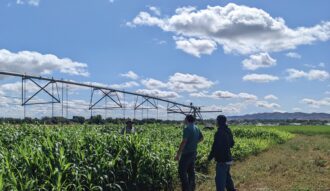There’s a reason so many of the climate-related projects funded by Western SARE focus on water.
“In Utah and much of the West, water scarcity is the number one issue when it comes to the future of agriculture,” explained Matt Yost, an Agroclimate Extension Specialist at Utah State University. “The pressure on water systems is just intense.”
Not surprisingly, access to sufficient water was listed as one the top information needs in a 2022 Western SARE needs assessment of cooperative extension educators.
Yost’s role at Utah State is to help agricultural producers deal with water scarcity in comprehensive, long-term ways. He’s now received two Western SARE Research and Education grants to study stacked water conservation practices.
“The goal is to look at several of the most promising options for optimizing water use,” he said. “We’ll look at them individually, and also look at suites of practices and test these combinations for a long time.”
Duration is an important part of the research. One shortcoming of most earlier irrigation studies is their short duration, Yost explained.
“There are many long-term studies on fertilizer and tillage, but most irrigation studies are just for a few years,” he said. “There’s a huge need to look at irrigation, crop and soil practices all combined and to see what the repeated effects of these practices are over 10 or 15 years or more.”
As you would expect from research seeking comprehensive, long-term solutions to drought in the West, the practices being studied can best be described at “all of the above.” They include:
- Deficit irrigation
- Drought-tolerant crops
- Efficient sprinkler packages
- Alternative crops
- Precision irrigation management
Yost’s team of researchers and cooperators in Utah and Idaho has produced fact sheets for many of these topics, each focused on the individual benefits growers might realize from adopting them, but work continues to identify and document the best combinations of practices. But even before that is complete, Yost’s research is having real on-the-ground impacts.
“The research into different sprinkler types came at a perfect time,” he explained. “Utah was in a mega-drought and the state made massive investments in water optimization. There was $70 million in federal relief money put toward optimization projects, and in the last legislative session, the state earmarked another $200 million to help growers optimize their water use.”
And with fresh research results, growers didn’t have to guess or decipher marketing hype about what kinds of irrigation improvements to make and there was a large conversion to low-elevation precision application, or LEPA systems, with state grants paying half the costs and growers finding matching funding for the rest.
“Many of the advanced sprinkler technologies could produce similar yield with 25 percent less irrigation than the conventional sprinkler at 100% irrigation,” Yost said. “This was a good sign that these irrigation systems might be a way to save water. The tricky part is that they did not always do this and we are working on better understanding when and where they might help consistently save water.”
An additional focus of Yost’s first SARE project was studying zonal irrigation systems – center-pivot irrigation setups that can turn individual sprinklers on and off anywhere during the rotation so it isn’t slices of the circle that get more or less water, but individual rows or pockets of the field. One focus of the new grant is to transfer the zone-irrigation approach to the more common, accessible and affordable sector irrigation. Sector irrigation can speed up or slow down to adjust the amount of water applied as the sprinklers complete the circle. (Picture a pie with different slices receiving more water than others.) This capability is available on almost all pivots in the Western United States.
The team has six new trials of sector irrigation underway, with two locations in Utah and four in Idaho. And while Yost believes variable-rate, sector-based irrigation can save significant amount of water, it’s going to be just one part of the all-of-the-above solution.
“We have also been testing alternative crops such as teff and sorghum sudangrass,” Yost said. “These crops require less irrigation than alfalfa and corn and were also often able to withstand the 25 percent irrigation reduction with the low-elevation sprinklers. We are just starting to test some different pasture grass varieties, Italian ryegrass, hybrid rye, and some other alternative crops and will have more information on them in the future.”
The project team also launched an Irrigation Technology Cost/Benefit Analysis Calculator online that lets growers compare various options to see what practices could be the most cost-effective to implement and have the biggest water savings. View the calculator.
“We’re collecting massive amounts of data and analyzing each practice individually and then all the combinations of practices,” Yost said. “Where multiple practices do have water-saving benefits, we’ll update the fact sheets and the online calculator to show those combined benefits.”
